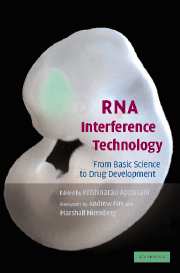8 results
Frontmatter
-
- Book:
- RNA Interference Technology
- Published online:
- 31 July 2009
- Print publication:
- 17 January 2005, pp i-vi
-
- Chapter
- Export citation
Foreword by Andrew Fire
-
- Book:
- RNA Interference Technology
- Published online:
- 31 July 2009
- Print publication:
- 17 January 2005, pp xi-xii
-
- Chapter
- Export citation

RNA Interference Technology
- From Basic Science to Drug Development
-
- Published online:
- 31 July 2009
- Print publication:
- 17 January 2005
Contents
-
- Book:
- RNA Interference Technology
- Published online:
- 31 July 2009
- Print publication:
- 17 January 2005, pp vii-x
-
- Chapter
- Export citation
List of Contributors
-
- Book:
- RNA Interference Technology
- Published online:
- 31 July 2009
- Print publication:
- 17 January 2005, pp xv-xxxiv
-
- Chapter
- Export citation
Foreword by Marshall Nirenberg
-
- Book:
- RNA Interference Technology
- Published online:
- 31 July 2009
- Print publication:
- 17 January 2005, pp xiii-xiv
-
- Chapter
- Export citation
Index
-
- Book:
- RNA Interference Technology
- Published online:
- 31 July 2009
- Print publication:
- 17 January 2005, pp 497-510
-
- Chapter
- Export citation
Plate section
-
- Book:
- RNA Interference Technology
- Published online:
- 31 July 2009
- Print publication:
- 17 January 2005, pp -
-
- Chapter
- Export citation



